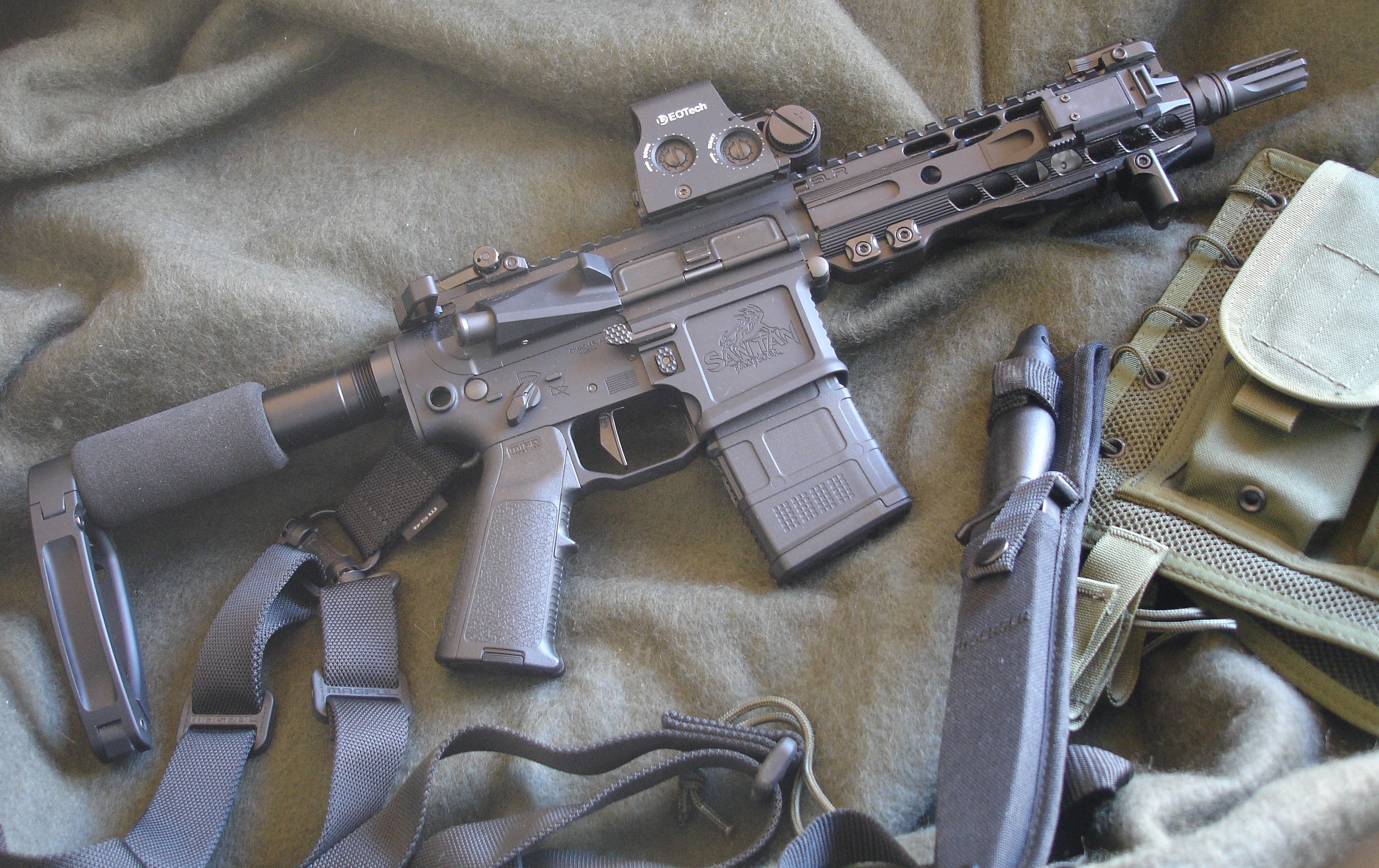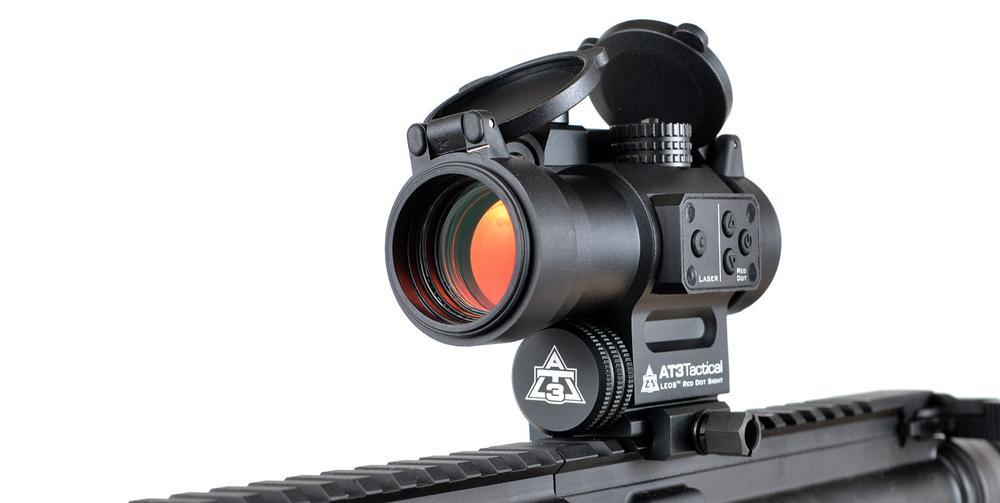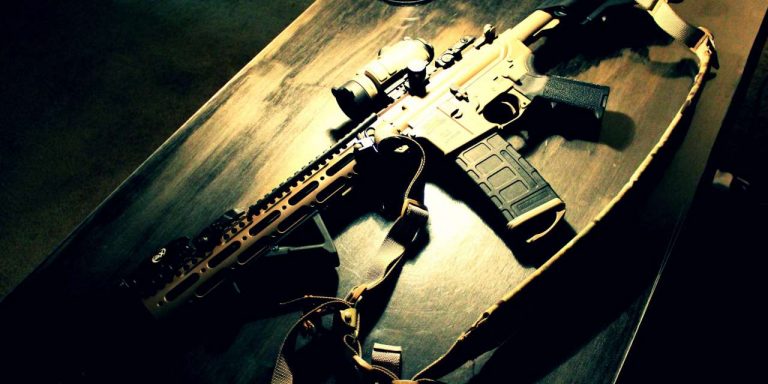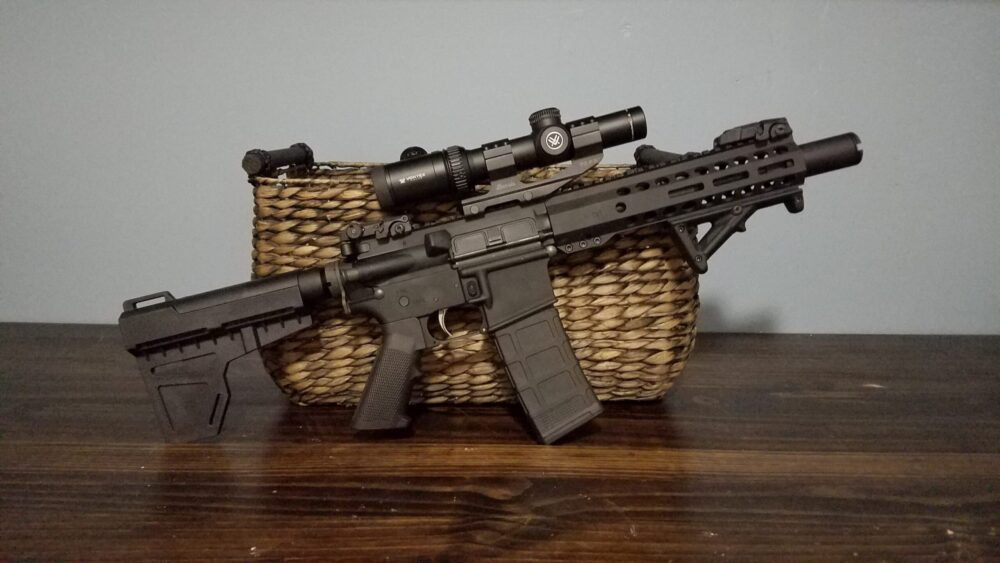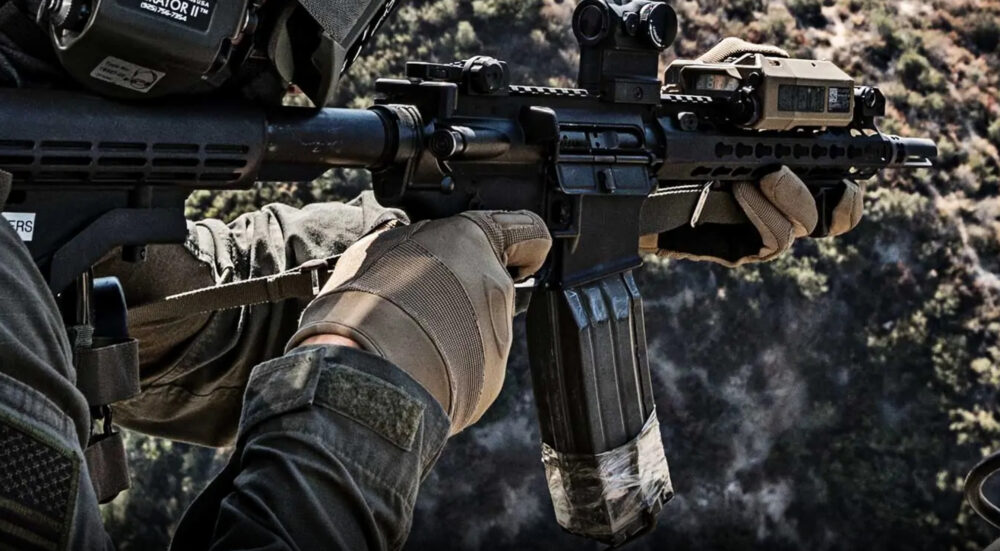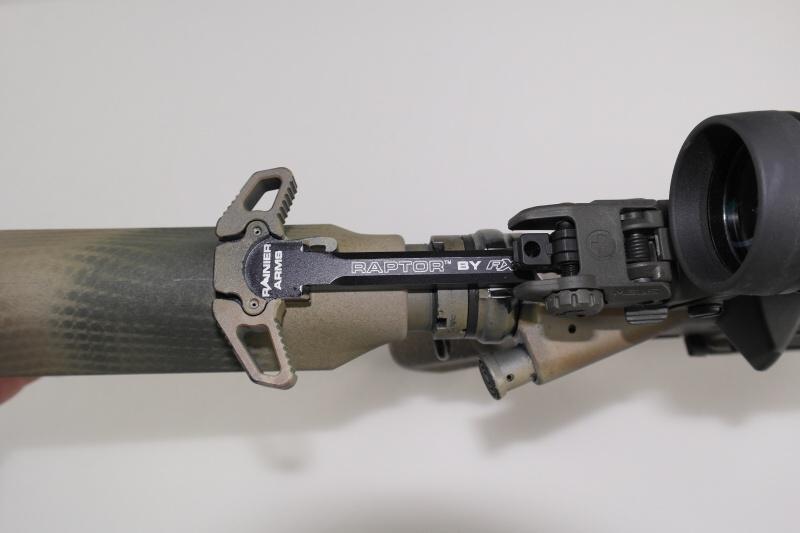There’s a lot of time that goes into building the perfect AR-15.
Whether you’re working on your first build or you’re an experienced gunsmith, you’ve probably spent countless hours researching barrels, triggers, handguards, and various other parts with the hopes of building the perfect AR-15 for you.
And no matter how experienced you are at building AR-15s, there’s always one step of the way that feels more complicated than it should – selecting the right bolt carrier group.
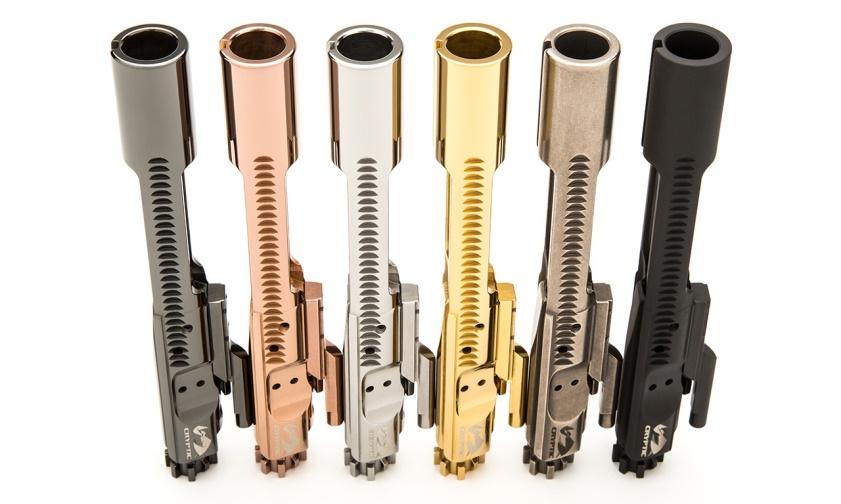
The challenge with choosing the perfect bolt carrier group is that there are a lot of different types of models to choose from. To further complicate matters, there’s a lot of jargon associated with bolt carrier groups.
Between the unnecessary phrases and acronyms like full-auto and TiN, the average hobbyist has a difficult time actually understanding the differences between various types of bolt carrier groups.
Cheap BCGs: Is It Worth It?
Some hobbyists will invest a lot of money to make sure that they’ve got the best barrel and trigger system for their AR-15, and then they’ll buy a cheap BCG for their gun just so they can save $40 or $50. We don’t recommend using the BCG as a way to cut costs for a couple of reasons.
Firstly, there’s not a huge difference in price between a cheap BCG and a reliable one. A mid-range BCG that’s dependable will cost roughly $50 more than a cheap one.
Also, high-quality BCGs are often made from a material that reduces heat and friction, which helps limit the stress and the wear-and-tear put on your gun over time.
Different Types of Bolt Carrier Groups
When researching various BCGs for your AR-15 build, you’re going to come across a number of different types of versions. Each one operates a little differently, and knowing these differences will help you determine which one is right for your gun.
The Semi-Automatic BCG
When it comes to price, semi-auto BCGs are often the least expensive of the bolt carrier groups.
While that doesn’t mean that semi-auto BCGs are necessarily cheap and of poor quality, it does mean that they’ve been overshadowed by their full-automatic counterparts.
Just as the name suggests, semi-auto bolt carriers have been specifically designed to only support semi-auto fire. This was achieved by cutting off part of the bottom of the bolt carrier so that the bolt carrier wouldn’t engage the sear release, allowing the gun to fire fully automatic.
While an understandable precaution set in place to prevent the use of automatic weapons, the problem with semi-automatic BCGs is that they never were really necessary.
In fact, the vast majority of civilian AR-15 builds don’t have a sear release located in their trigger group, which means that regardless of whether your BCG is a semi or fully-automatic variant, it’s only capable of semi-auto fire.
And for someone to actually convert their AR-15 into a fully-automatic rifle, they’d have to go out of their way to acquire parts that aren’t readily available and then modify their gun.
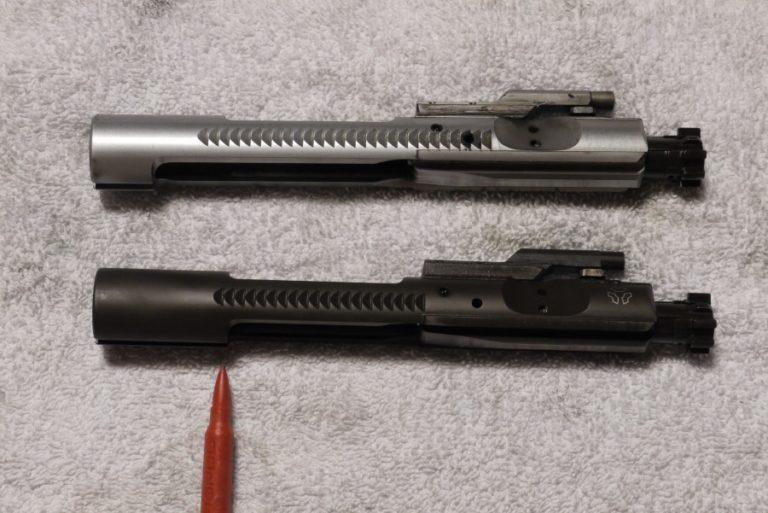
The biggest overall advantage that semi-auto BCGs have over their full-auto counterparts is their price. You can expect semi-autos to be significantly cheaper, with decent quality pieces averaging around $100.
There’s also one functional advantage that the semi-auto BCG has: weight. Due to the fact that part of the BCG has been cut off, semi-auto BGCs are lighter than full-auto ones.
The Full-Auto BCG
The term “full-auto bolt carrier group” is a bit misleading in that it doesn’t actually make your gun fully automatic. In order to do that, you’d also need a number of fully-auto components, including a sear and disconnector, along with your FA BCG. And not only are all of those parts difficult to find, acquiring them would probably put you in violation of a number of serious Federal laws.
But still, your FA BCG can be used in a fully-automatic AR-15, unlike a semi-auto one.
The good thing about FA BCGs is that they’ve become quite standard in recent times, so finding the perfect one for your gun should be fairly simple.
Moreover, FA BCGs are roughly one ounce heavier than semi-automatic ones and slightly longer as well.
This is because the lug on the rear portion of the FA BCG isn’t been sawed off. It’s actually this lug that makes the FA BCG capable of automatic fire – provided you’ve got the rest of the automatic components.
Considering FA BCGs are more expensive than semi-automatic ones, combined with the fact that they don’t really support automatic fire, you might be wondering why anyone would want to pay more money for a BCG that does the same thing as the semi-auto.
The truth is that FA BCGs also tend to be more durable than semi-automatic ones.
This is because all FA BCGs have shrouded firing pins, which helps evenly distribute force throughout the carrier and to the hammer. Bolt carrier groups with unshrouded firing pins, on the other hand, experience more wear and tear and can cause your firing pin to break after excessive use.
The Mil-Spec BCG
When it comes to firearms, “mil-spec” is a buzzword that’s often used to increase sales by associating products with the US Military.
The important thing to remember before you buy any mil-spec part is that the term mil-spec means that the piece meets military specification.
It does not mean that the part is superior to other parts on the market. In fact, there’s a lot of premium, match-grade equipment for AR-15s that are much better quality than mil-spec parts.
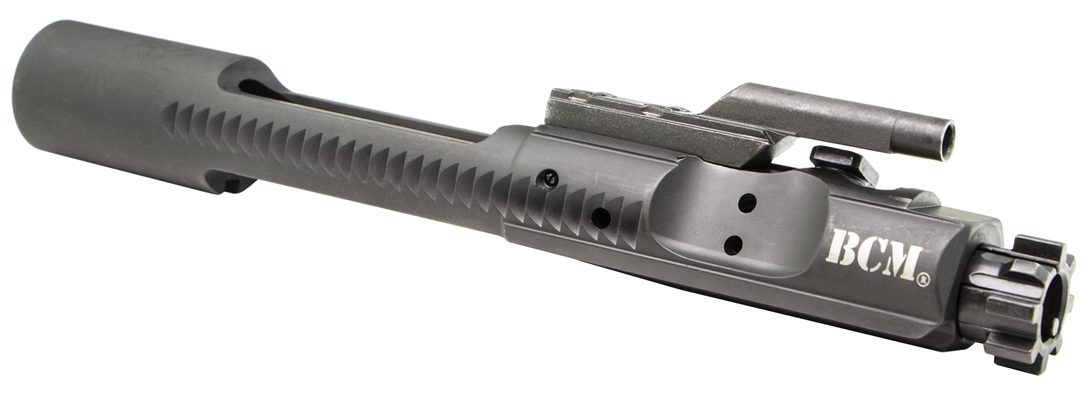
BCM M16 Mil-Spec Bolt Carrier Group
Pros
- Meets milspec requirements, but at a much higher level of quality
- Simple, but works every time
With that said, it’s safe to say that mil-spec parts are of good quality. More often than not, they’re designed specifically for functionality and are constructed to withstand moderate to heavy use.
In order for a BCG to be truly mil-spec, it has to be of the full-auto variety. Which makes sense, because military rifles like the M4 and the M16A2 are both capable of firing full auto.
Aside from that, mil-spec BCGs need to also meet the following other guidelines:
- High-pressure testing.
- A magnetic particle inspection (MPI).
- Bolts are made of 8620 steel.
- Heat treatment, followed by shot peen.
- Interior of the bolt carrier and carrier key are chrome lined.
- The bolt and bolt carrier are coated with a matte black mil-spec finish.
Another thing to remember when choosing BCGs and other parts for your AR-15 is that some hobbyists use mil-spec guidelines to set the standard and won’t go below them.
Lightweight BCGs
The newest and most popular type of bolt carrier group on the market is the lightweight BCGs, also known as low-mass bolt carrier groups. Like the name suggests, lightweight BCGs weigh significantly less than their semi and full-auto counterparts.
To give an idea of just how light the low-mass BCGs are, consider the following: your mil-spec bolt trigger group weights around 11.5 ounces in total, while a lightweight BCG averages around 5.75 ounces, which is half the weight. For competitive shooters and hobbyists looking to cut back on as much weight as possible, lightweight BCGs are a great way to lose some unnecessary ounces.
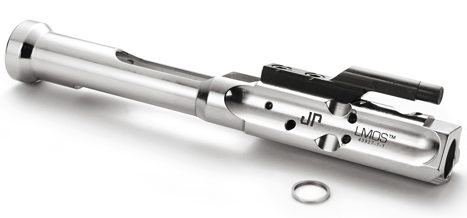
JP Stainless Steel Low Mass BCG
Pros
- Roughly half the weight of a milspec BCG
- Ounces equal pounds, pounds equal pain
Cons
- Effectively requires an adjustable gas block to tune the rifle correctly
Along with reducing the overall weight of your gun, lightweight BCGs are sought after because they provide a smoother shooting experience with less muzzle movement and reduced recoil. The reason for this is simple: as you fire your gun, gas pressure from the fired round pushes the BCG back, cycling the ammo.
The heavier the BCG weighs, the more recoil you’ll feel as a result. So when you fire with a lightweight BCG, you experience significantly less recoil because of its lower weight.
The lower mass of lightweight BCGs also helps them move faster, thus causing your gun to cycle through ammo more quickly than it would with a mil-spec or semi-auto BCG.
For the casual firearms enthusiast, the advantages of a lightweight BCG might not seem worth their hefty price tag, which can run between $350 and $450.
But if you’re a competitive shooter in need of a high-performance rifle for your 3-Gun competitions, and you’re prepared to spend a little extra money building a gun finely tuned for your specifications, we recommend going with a lightweight BCG and an adjustable gas block.
Different Types of Material for Your BCGs
Bolt carrier groups come in a lot of different types of material, and what they’re made of will determine how durable, reliable and expensive your part will cost. Let’s look at some of the different materials used to make BCGs.
Steel BCGs
There’s a reason why steel is commonly used to make BCGs and other parts of the AR-15 and other guns. Steel is reliable, hardy enough to withstand heavy use, and it’s affordable.
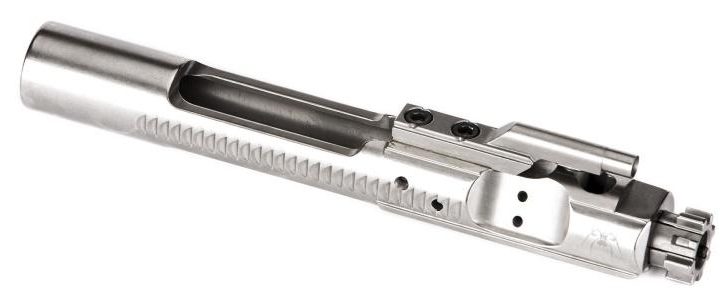
Spike's Tactical Nickel Boron BCG
Pros
- Steel for ultra high durability
Cons
- Heavy
Almost all steel BCGs are built from 8620 steel, which is the same type of steel used in mil-spec BCGs. The only real exceptions to this are Carpenter 158-steel carriers, as well as a range of lightweight stainless steel BCGs developed by JP made from 416 stainless steel.
The latter is said to be better quality than their mil-spec counterparts.
Aluminum BCGs
Because of its lightness and strength, aluminum is commonly used for lightweight bolt carrier groups. In fact, aluminum is approximately 40% lighter than titanium, another popular lightweight BCG metal.
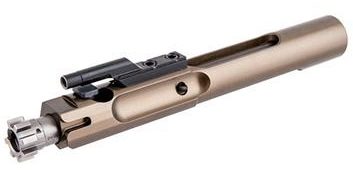
JP Enterprises AR-15 Ultra-Low Mass BCG
Pros
- Aluminum
- Weight: 2.9oz
Cons
- Extreme price tag
Because of its low mass, aluminum BCGs reduce the recoil, making it easier for the shooter to make accurate follow-up shots. The downside to aluminum BCGs is that they’re not able to take a lot of wear and tear. Even when the material has been given a hard anodized coat, excessive contact with heavy hammers can deform the metal over time.
Because of this, we recommend using aluminum BCGs for competition use only.
Titanium BCGs
Titanium bolt carrier groups offer the lightweight advantage of aluminum with the durability and dependability of steel. Most manufacturers that make titanium BCGs use 6AL-4V titanium alloy. This material is used extensively in racing and aerospace industries – including commercial aircraft like the Boeing 787.
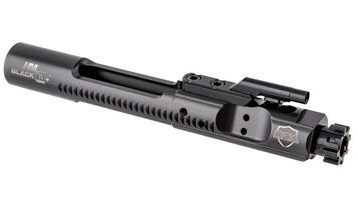
Rubber City Armory Titanium BCG
Pros
- Lighter than steel, stronger than aluminium
- Designed for 3-Gun or other shooting competitors
Cons
- Costs as much as a new budget rifle
While titanium isn’t as light as aluminum, it is roughly 40% lighter than 8620 steel. It’s also more resistant to corrosion and breakage. With that said, titanium is softer than steel, which makes it vulnerable to excessive friction. To mitigate this, most manufacturers spray their titanium BCGs with a hardening finish like nickel boron to keep them protected.
Still, titanium is one of the best materials if you’re able to spend $300 or more on a BCG. Its versatility makes it the perfect material, regardless of whether your AR-15 is used for home defense, competitive shooting, or just range shooting.
Hybrid BCGs
As the name suggests, hybrid BCGs are made from one or more of these materials being mixed together with other metals. One of the more common hybrid materials is a mixture of steel, titanium, and aluminum.
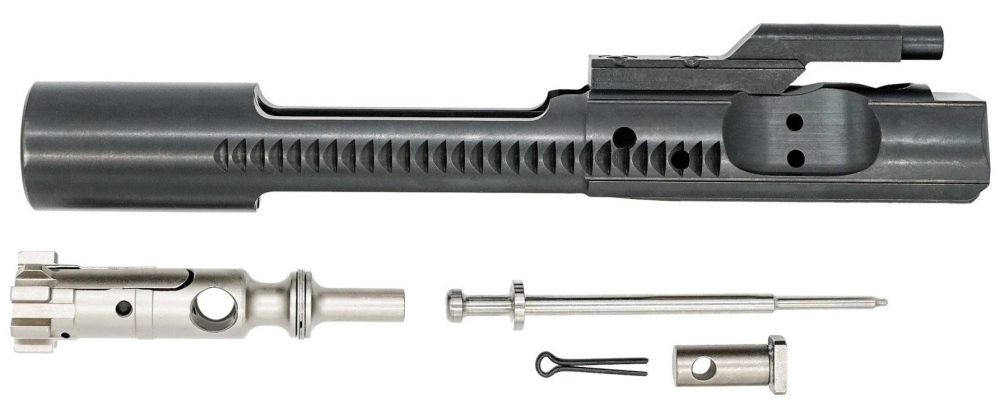
Generally speaking, most hybrid BCGs are designed to fulfill certain properties – like increased strength and reduced weight. For this reason, they’re usually some of the more expensive types of bolt carrier groups on the market.
With that said, hybrid BCGs are hard to classify and generalize due to the fact that there’s not a standard material that companies work with. For example, with steel, we know that most manufacturers use 8620. But with hybrid BCGs, things aren’t as clear-cut.
In fact, you’re probably not going to get the same metal used uniformly throughout the part. Some parts of the BCG may be aluminum, whereas others could be titanium or steel.
For this reason, it’s best to look at hybrid BCGs as individual products rather than its own unique grouping.
For example, in the Vella Industries Hybrid BCG pictured above the carrier is made of hardened titanium, the fireing pin is also titanium, the bolt is 9310 steel coated with Nickel Boron, and the gas key is hardened billet 4340 steel.
Different Types of BCG Coating
These days, it’s not just titanium BCGs that receive a special coat – most mid-to-high range BCGs are given a coat for strength, protection against heat, and various other properties. Here are some of the common types of coating that you’ll probably come across when shopping around for your next BCG.
Nickel Boron Coatings
Albeit expensive, nickel boron is one of the best coatings that you can have on your BCG.

WMD Guns 5.56 NiB BCG
Pros
- NiB coating makes cleaning easy and provides low friction
Cons
- Discoloration in the finish will occur after repeated use
It helps make your BCG more resistant to corrosion, in addition to reducing friction so that you can fire your gun without as much lubrication.
Phosphate Coatings
Phosphate is the gray or matte black that your average BCG is coated with.
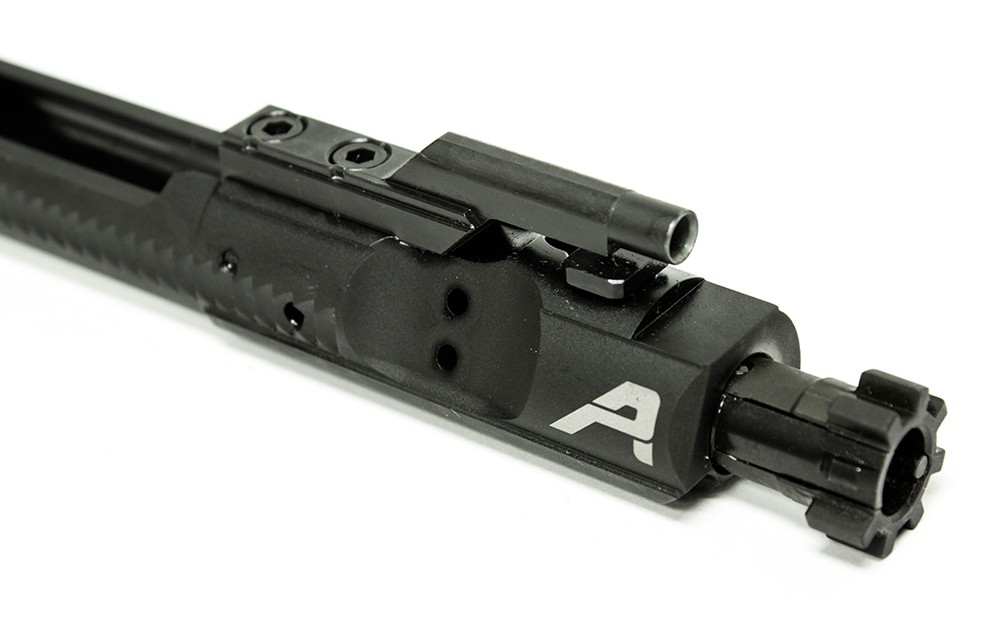
Aero Precision Phosphate BCG
Pros
- High durability
- High heat resistance
Cons
- Keep well lubed to prevent wear
Stronger than nickel boron, phosphate gives your BCG a hard, protective layer so think that it actually increases the overall thickness of your bolt carrier group. Despite its strength and heat-resistant properties, phosphate is more vulnerable to friction and tends to break down after excessive use.
Ion-Bonded Coatings
Said to bring the best qualities that phosphate and nickel boron have to offer, ion bonding provides the hardness of phosphate with nickel boron’s protection against friction.
This means that your BCG is coated with a hard protectant that keeps it better protected against corrosion and heat.
The general consensus is that a nickel boron coating provides a smoother finish, but ion bonding is a close second.
Titanium Nitride Coatings (TiN)
TiN coatings give the smoothness of nickel boron, but with a sleek, gold finish.
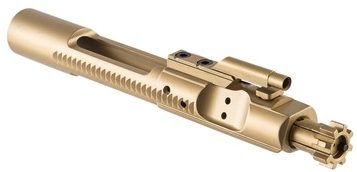
Brownell's 5.56 TiN BCG
Pros
- Titanium Nitride coated
- Magnetic Particle inspected
For this reason, this type of coating is incredibly popular among hobbyists who enjoy customizing their gun for aesthetic reasons. However, when it comes to performance, TiN coatings don’t serve much of a purpose over nickel boron other than looking nice.
Putting Your BCG through the Stress Test
Bolt carrier groups go through a lot of stress from frequent usage, which is why people are willing to spend extra money on high-quality metals and different types of coatings. To guarantee that BCGs are as durable and reliable as the manufacturers say they are, these parts are often tested to see just how well they’re able to perform.
The Magnetic Particle Inspection
One way that BCGs are assessed is through a magnetic particle inspection. This test scans the surface for imperfections and cracks that could compromise the quality of the BCG. The process works by magnetizing the BCG and then applying iron particles to its surface. Any areas on the BCG with small cracks and scratches should pull these particles towards them, thus revealing the defects.
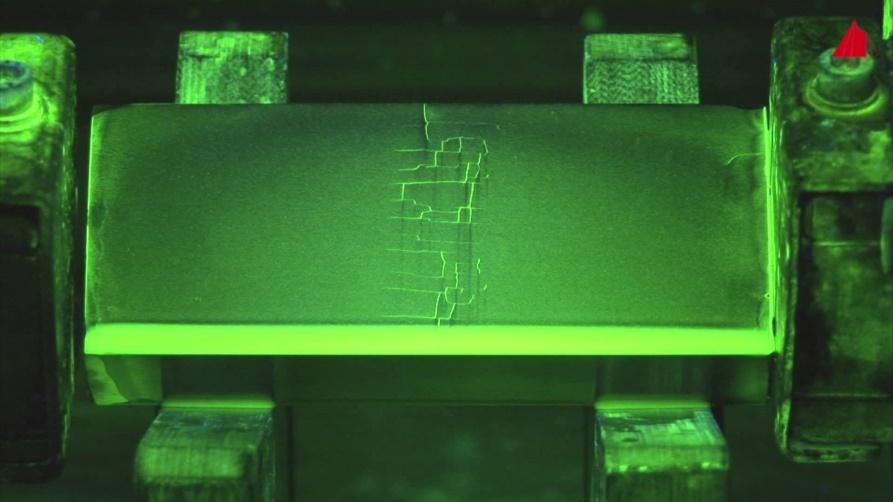
High-Pressure Testing
High-pressure tests are designed to place the BCG under the same type of pressure they’d experience when firing a live round. The purpose of this type of testing is to make sure that the part is strong enough to be used in the field. However, this type of test is also the source of a lot of criticism, as some experts believe that high-pressure testing permanently weakens the BCG, effectively reducing its lifespan in the process.
One More Thing about Testing
When BCGs are tested, they undergo one of the following types of testing: batch testing or individual testing.
Like the name suggests, batch testing assesses the quality and craftsmanship of an entire batch of BCGs. The benefit of this kind of testing is that it has lower labor costs, which means a cheaper price tag for you.
The downside, however, is that there’s always the possibility that each BCG isn’t getting the attention they deserve, which means that some defective pieces could make it through the testing phase.
With individual testing, on the other hand, pieces are given a rigorous testing on a one-on-one basis.
This gives companies more time to thoroughly inspect the product, looking for minor defects that could’ve been overlooked in batch tests. The downside is that individual testing requires more labor, which means that the individually-tested pieces are more expensive as a result.
The Bottom Line
When it comes to bolt carrier groups, there’s a lot of information to digest before choosing the right part for you.
The good news is that it doesn’t have to be complicated as it looks.
If you intend on building a standard AR-15, we recommend going with a semi-auto or mil-spec BCG.
Both get the job done just fine.
If you’re a competitive shooter, on the other hand, aluminum offers a lot of shooting advantages, provided your fine with changing BCGs after heavy use.
For everything else, we recommend titanium.


